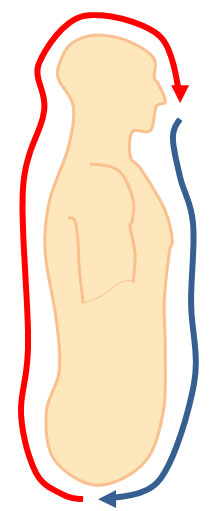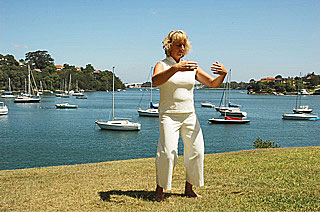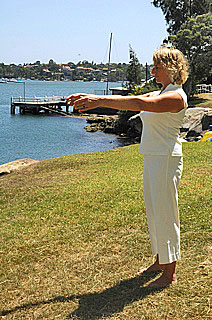
sponsor: Qi Journal
Navigation:
Portals
article: An Introduction to the Fine Art of Qigong | date: 2023-11-22 10:26:05 | Find articles by this author
|
|
An Introduction to the Fine Art of Qigong
This article is an introduction to the art of Qigong. If you practice it patiently each day, in time you will be rewarded with improved health and fitness. It makes no difference whether you are young or old, fit or unfit, overweight or underweight, you will look better but most importantly, you will feel better than when you began. Why am I so confident? For over forty years I have included Qigong in my exercise program and I have seen it transform others as well as myself and so I believe that it can benefit you too. Incorporating Qigong into one's life is a form of health insurance because it helps your internal organs and your glands to function properly. As long as you are putting the good fuel of fresh and natural food, water and air into your body, a regular practice of Qigong should facilitate slowing the aging process of your cells. Breath and breathing training is an important and integral and necessary part of Qigong, and Taijiquan (Tai Chi)—which itself is an elaborate form of Qigong. We take long, slow deep breaths which calm and connect the mind and body, which is also an essential part of the Qigong process. Slow, deep breathing coupled with specific postures and movements helps to oxygenate the cells, so they are better nourished with both blood and oxygen. This helps in removing toxins and replenishing cells with fresh Qi. What is Qigong?Qi, which is pronounced 'chee', as in 'cheese' and sometimes written as chi, is Chinese for the life force energy that permeates all living things, including Mother Earth. Gong means hard work or achievement through disciplined activity such as exercise. Qigong is a healing art using a series of gentle focused exercises for body and mind. It is a well-known fact In China that the regular and consistent practice of certain Qigong exercises has the potential to slow the aging process. People of Eastern Asia are well known for having a youthful appearance into old age. While there are many and varied reasons for this, the Chinese have known for several thousand years that the best way to maintain one's youthful looks and vigour is to take care of one's Qi. This is where Qigong comes in, as it is an excellent way to generate Qi and to keep it moving throughout the body. In Traditional Chinese Medicine [TCM] the continuous flow and movement of Qi through the meridians (energy pathways) of the body is considered essential in keeping the body healthy and warding off disease. Both Qigong and TCM operate from the quantum perspective that Qi controls or rules the body. Thus whatever is going on at the physical level is a direct reflection of what is going on with your Qi. It also tells a lot about your thoughts and beliefs, because what you think about yourself informs your Qi of what to do (or not do) within your body. As a practitioner of TCM for over thirty-five years it is my opinion that the most effective way of maintaining health and vitality and warding off disease is by cultivating your Qi, and that the practice of Qigong is the most effective way to achieve that. Qigong ExercisesThere are many different varieties of Qigong exercises. Some have quite dynamic movements, others are static; some are meditations others visualisations; but they all have a basic foundation and that is what I am going to teach you here. If you master these two postures and can do them for around twenty minutes a day, you will begin to notice some of the above mentioned benefits. First we need to learn how to stand correctly, StandingStand with your feet shoulder-width apart and parallel; your arms by your sides with palms slightly facing the back; your head is upright and your chin tucked in a little so that the crown of your head is uppermost. Feel or imagine that a string is connected to your crown point and supporting you from above. Now allow your weight to rock forward slightly onto the balls of your feet as you keep your heels to the ground. Then rock back so that more weight is on your heels with your toes still flat on the floor. Move back and forward a few times to get a sense of the different feelings, then find your centre – your weight should be neither too far forward nor too far back. This is your Qigong standing position. BreathingHave you ever watched a baby breathing? Their belly rises and falls as they breathe in and out. This is what the Chinese consider to be our natural breath and this is how we should breathe in Qigong. While standing as above place your hands over your lower abdomen just below your belly button. Women place right hand over left, and men do the opposite. Begin to breathe in while expanding your lower abdomen. Feel your hands being pushed outwards; then as you breathe out let your abdomen relax and gently contract inwards. Breathe in and out through your nose. Do not force your breath, keep it natural. Continue to breathe in this fashion throughout the whole exercise. 
Connecting the Meridians Connecting the Small Heavenly CycleWhile standing and breathing as above, place your tongue on the roof of your mouth, just wherever it feels comfortable. This action acts like a switch to connect two meridians: the Ren Mai [Conception Vessel] which travels from the base of the body up the centre-line to the bottom lip; and the Du Mai [Governing Vessel] which emerges from the same point at the base of the body and travels up the spine, over the head and ends at the top lip. During the practice of Qigong you will activate the movement of Qi through these meridians causing it to flow as a cycle around the body, up the back and down the front. Holding the Ball to Strengthen the Body and Cultivate the QiThis first exercise is very powerful and while it may seem quite simple, just try to do it for five minutes and then think about how simple it is! There is a saying in Daoist philosophy, "Do nothing and everything is done." In this exercise apparently you are doing nothing – but as you will soon discover there is a lot going on inside!  Part 1: Begin by standing and breathing as above, with your tongue on the roof of your mouth. Now slightly bend your knees, as if you are resting your buttocks on the edge of a bench. Your knees must be in line with your toes, and never over them; tilt your hips slightly back and your buttocks slightly forward. This should cause your lower back to relax. Your back is straight and your head upright. Part 2: Gently raise your arms up in front of you as if they were holding a big ball that fits between your hands and chest. The palms of your hands face your chest, and your elbows are dropped down slightly. Your arms and shoulders must be completely relaxed. If it helps you may imagine that your elbows are resting on big balloons and that your arms are being held up by helium-filled balloons, also that you are sitting on a big ball. By this time, if this is new to you, your thighs should be starting to ache and if not then you are not bending them enough, so sit down a little further. This is the most important part of this exercise as it is this posture that actually helps to generate Qi. You may also be starting to sweat slightly and you should be feeling your heart and pulse rate increase. Now your arms will start to ache too and here comes the next most important part of the exercise: Ignore the pain and keep breathing slowly and deeply; at least for a couple of minutes because this also is how you get to train your mind. If you give in to your mind saying: "This is too hard!" – "I'm in pain!" – "This hurts!" and you stop, then you will not cultivate your Qi. Given that you have no physical disability that prevents you from doing these movements or postures—(and if you do have such a disability you should not being doing this or any other Qigong without specific oversight by a professional)—then in time the pain should decrease and, as with any sport or exercise, after awhile your muscles will just get used to it. Begin with doing the Standing about a minute or two a day, slowly building it up to ten minutes, and eventually if you are able to, up to twenty minutes. It's best to do it without any external distraction, like music or TV or radio. Simply focus on your breathing and the benefit you are giving your body. To finish, gently lower your arms and slowly straighten your legs, place your hands over your lower abdomen as above, continue to breathe slowly and deeply while mentally scanning your body for areas of tension. Keep your mind on those areas for a few moments while breathing and imagine them relaxing. As simple and straightforward as this may seem, this is one of the most powerful Qigong exercises you can do. It generates Qi as well as allows the Qi to flow harmoniously throughout the body. The next exercise is less strenuous yet equally beneficial. The Pendulum to Empty the Mind and Feel the Qi Begin by standing as above with your tongue on the roof of your mouth and your arms by your sides. Turn your hands so that the palms face in toward the body and breathe slowly and deeply. Now think about how a pendulum swings, it moves through an arc, swinging effortlessly. Your arms are the pendulums; begin to let them swing back and forward, keeping elbows straight but not locked tight. Allow your arms to swing forward and back an equal distance feeling the rhythm and momentum of the swing take on its own life without you really having to make your arms move. Having achieved this keep the movement going and just think about your hands. The Chinese say "put your mind in your hands." This is important as it helps free up your mind and your shoulders, because where your mind goes your Qi flows. So putting your mind in your hands draws any stuck or blocked energy around your shoulders, neck and head down your arms and into your hands. You can even imagine that this energy is flowing out of your fingers if you wish. Continue this for five minutes. Then simply allow the movement of your arms to slow down, all the while still keeping your mind in your hands. Notice how your hands are feeling – they may be pulsing, feel big or tingle, whatever you feel, this is your Qi. When the movement seems to have completely stopped bring your hands to the lower abdomen as before and feel the Qi from your hands merge with your lower abdomen. This area is the key Qi storage centre in the body, so allow yourself some time to stand and let the Qi settle. This Qigong exercise helps free the neck and shoulder area from stress and tension. It stills the mind and is good to do before going to bed if you are having difficulty sleeping. It activates the Qi of the lungs, heart, liver and spleen, generally helping to improve the function of these organs. Together these Qigong exercises, when done regularly, will help your body and mind to come back to or maintain a state of balance. Editor's Comments:This entry was taken with the author's permission from taowayoflife.com. |
